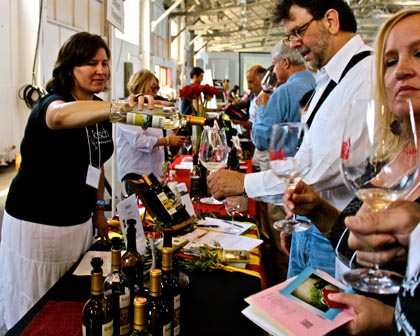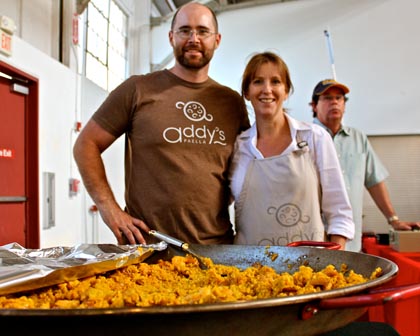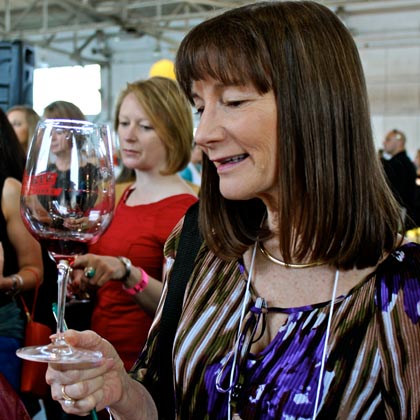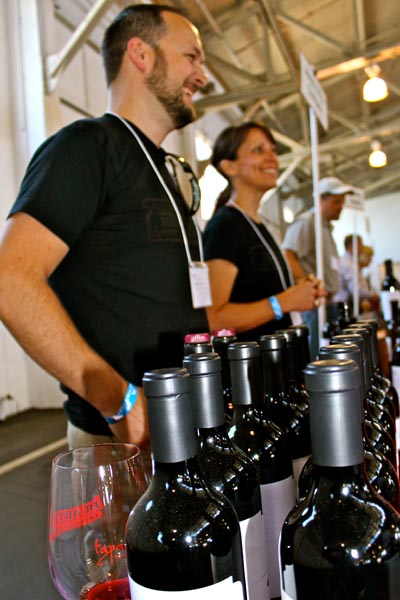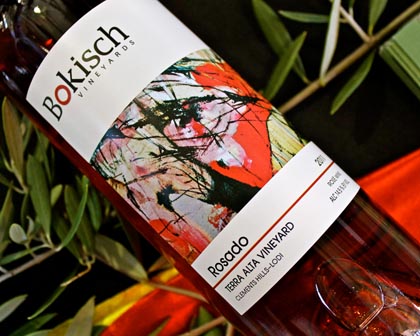Letters from Lodi
An insightful and objective look at viticulture and winemaking from the Lodi
Appellation and the growers and vintners behind these crafts. Told from the
perspective of multi-award winning wine journalist, Randy Caparoso.
Going mad about saffron & Iberian grapes at the TAPAS Grand Tasting
Bokisch Vineyards' Concetta Zoria Wilkens pours for the TAPAS crowd
46 wineries and growers presented cutting-edge wines made from grapes of Spanish or Portuguese origin at the 5th annual TAPAS (Tempranillo Advocates Producers & Amigos Society) Grand Wine Tasting in San Francisco’s Fort Mason this past Saturday, June 9.
Yet one could argue that the biggest hit at this year’s TAPAS showcase was not a wine or winemaker, but a dish: the sumptuous, golden paella made by Lodi’s own Addy’s Paella, which has to be tasted to be believed: saffron infused rice (utilizing authentic arroz from Spain), shrimp, chicken, Lockeford sausage, and the most pungent, garlicky aioli made west of Madrid.
Addy with one of her 3 ft. paella pans
But don’t take our word for it. Addy – who was inspired to start her open fire paella catering business after several visits to Spain to see an expatriate sister – already created a sensation last November at the Berryessa Gap Paella Cook-off, taking a unanimous first place in competition with 17 other paella chefs from Northern California and the Bay Area. Not bad for a first timer!
Ellen Landis, sommelier/owner of Landis Shores, savoring a Tempranillo
So what’s the big deal about paella? Among all the classic dishes of the world, paella has just about the most elemental connection to wine. First and foremost is the taste of saffron, a spice that infuses a multiplicity of sensations; often unconscious, always jarringly intense – suggesting sea water, citrus peel, burnt hay, roasted clove, smidgens of anise, warm humus, dusty velvet, sun dried fruit, and often enough, perspiration and sex: the perfect set-up for wines made from Iberian grapes, which tend to be have more moderated, subtle, balanced, less fruit forward qualities than wines made from other grapes.
Example: the comparison of Cabernet Sauvignon and Chardonnay (two of France’s most famous grapes) with Tempranillo and Albariño (two native Spanish grapes). The aromas of Cabernet Sauvignon and Chardonnay based wines are usually very strong and distinctive in their fruitiness: there is no mistaking their varietal character.
Red wines made from Tempranillo, on the other hand, may be richly aromatic, but more difficult to define: smelling vaguely of red berries, and also like meats, hard spices, sometimes of dusty earth and even leather. White wines made from Albariño may be lighter and leaner than Chardonnays, but by the same token are crisper and more refreshing to the palate.
But when wines made from Tempranillo and Albariño are tasted with food, all of the sudden the ineffable becomes irresistible. Aromatic vagaries and lean bodies become neither here nor there because foods taste better and are easier to digest in context with such wines; and the wines taste richer and lusher in context with the foods. Contrast that with some of the world’s finest Chardonnays and Cabernet Sauvignon based wines, which are often said to taste best by themselves – foods are often a distraction.
Which would you rather have? Wines that are complimented by food (and vice-versa), or wines that are neither here nor there with food?
Jeremy Wine Company's Jeremy & Choral Trettevik at TAPAS
One thing we know: with Addy’s paella at the TAPAS event, it was hard to decide which of these wines tasted better:
- The flowery, goat’s cream, lavender sachet nuanced 2011 Bokisch Vista Luna Vineyard Borden Ranch-Lodi Garnacha Blanca ($16) which seemed to sing with the earthy saffron notes of the paella,
- The zesty, lanky, brightly perfumed, candied lemon and lemon thyme scented 2011 Quinta Cruz Silvaspoons Vineyard Alta Mesa (Lodi) Verdelho ($20), which lasered in on the plump shrimp and crunchy green onion of the paella,
- Or the wild berry/dusty loam and bitter chocolate notes of the 2008 St. Jorge Silvaspoons Vineyard Alta Mesa-Lodi Tinta Cao ($20) which had just enough chewy tannin in its moderately weighted body to pick up on the paella’s spiced sausages and pungent aioli.
This is what multifaceted dishes and wines do: they go great together for multifaceted reasons, even if not for the same reasons.
As you would expect, there were also some excellent West Coast grown Albariños being shown from the cooler than average 2011 vintage, which seems to have had the positive effect of making the wines taste all the more lighter and refreshing. The sparest of the bunch being the 2011 Odisea Dream Clements Hills (Lodi) Albariño ($18), with its lemon, lime, flower and flint qualities nimbly pressing all parts of the palate. The grower’s bottling, the 2011 Bokisch Terra Alta Vineyard Clements Hills-Lodi Albariño ($16), was just as bright and breezy, with an even more minerally flow in the feel. And while a tad leaner, the 2011 Jeremy Lodi Albariño ($18) was nonetheless zesty and mouth-watering.
Special kudos also need to go out to Fenestra, a Livermore Valley winery of long standing that has been sourcing a variety of Portuguese grapes from Ron Silva’s Silvaspoons Vineyard, in Lodi’s Alta Mesa AVA. The 2011 Fenestra Silvaspoons Vineyard Lodi Verdelho ($15) is a beautifully fragrant white; lissome, bright and electrical in its delicacy. At the opposite end of the scale, the 2007 Fenestra Silvaspoons Vineyard Lodi Touriga ($22) is big, meaty and rotund – a red wine you can practically eat with fork and knife.
There were also a number of Tempranillos good enough to eat: notably, the lush, zippy, black cherry toned 2010 St. Jorge Silvaspoons Vineyard Alta Mesa-Lodi Tempranillo ($20); the firmer yet fluid 2009 Harney Lane Lodi Tempranillo ($25); and the smooth yet fleshy, resplendently red berryish 2009 Bokisch Lodi Tempranillo.($21).
On the exotic side, the 2011 Forlorn Hope La Gitana Alta Mesa-Lodi Torrontés ($20), also sourced from Silvaspoons Vineyard, is fabulously fresh and crisp, with lemon skin, avocado and piña colada-like perfumes. The 2009 Quinta Cruz Silvaspoons Vineyard Alta Mesa (Lodi) Souzão ($20) has an almost slippery sleek medium body, bursting with candied violet and cake spice aromas.
Finally, most refreshing of all, the 2011 Bokisch Terra Alta Vineyard Clements Hills-Lodi Rosado ($16) is your ticket to sensational summer fiestas: positively plump with Bing cherry and herbes de Provence sensations, with touches of natural fruit acidity prickling and animating the palate.
Now try imagining this pink tinged wine with a paella made with truffle oil tossed arugula, lavender grill roasted tenderloins of pork, charred coiled of octopus, or infusions of tinta de calamar (black squid ink)?
¿Por qué no?
The view of San Francisco Bay from Fort Mason
